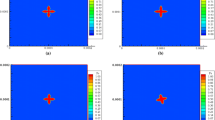Abstract
In this paper, we propose an efficient multi-mesh h-adaptive algorithm to solve the level set model of dendritic growth. Since the level set function is used to provide implicitly the location of the phase interface, it is resolved by an h-adaptive mesh with refinement only around the phase interface, while the thermal field is approximated on another h-adaptive mesh. The proposed method not only can enjoy the merits of the level set function to handle complex evolution of the free boundary, but also can achieve the similar accuracy as the front tracking method for the sharp interface model with about the same degrees of freedom. The algorithm is applied to the simulation of the dendritic crystallization in a pure undercooled melt. The accuracy is verified by comparing the computational dendrite tip velocity with solvability theory. Numerical simulations, both in 2D and 3D cases, are presented to demonstrate its capacity and efficiency.
Similar content being viewed by others
References
Brezina, M., : Algebraic multigrid based on element interpolation (amge). SIAM J. Sci. Comput. 22(5), 1570–1592 (2000)
Cleary, A.J., : Robustness and scalability of algebraic multigrid. SIAM J. Sci. Comput. 21(5), 1886–1908 (1999)
Gibou, F., Fedkiw, R., Caflisch, R., Osher, S.: A level set approach for the numerical simulation of dendritic growth. J. Sci. Comput. 19, 183–199 (2003). Special issue in honor of the sixtieth birthday of Stanley Osher
Glicksman, M.E., Marsh, S.P.: The dendrite. In: Handbook of Crystal Growth, vol. 1. North Holland, Amsterdam (1993)
Herrmann, M.: A balanced force refined level set grid method for two-phase flows on unstructured flow solver grids. J. Comput. Phys. 227, 2674–2706 (2008)
Juric, D., Tryggvason, G.: A front-tracking method for dendritic solidification. J. Comput. Phys. 123, 127 (1996)
Karma, A., Rappel, W.J.: Phase-field method for computationally efficient modeling of solidification with arbitrary interface kinetics. Phys. Rev. E 53(4), R3017–R3020 (1996)
Karma, A., Rappel, W.J.: Quantitative phase-field modeling of dendritic growth in two and three dimensions. Phys. Rev. E 57(4), 4323–4349 (1998)
Kim, Y.T., Goldenfeld, N., Dantzig, J.: Computation of dendritic microstructures using a level set method. Phys. Rev. E 62, 2471–2474 (2000)
Kurz, W., Fisher, D.J.: Fundamentals of Solidification. Trans. Tech. Publications Ltd., Aedermannsdorf (1989)
Langer, J.S.: Lectures on the theory of pattern formation. In: Souletie, J., Vannimenus, J., Stora, R. (eds.) Chance and Matter, pp. 629–711. North-Holland, Amsterdam (1987). Chapter Session XLVI
Li, R.: On multi-mesh h-adaptive algorithm. J. Sci. Comput. 24(3), 321–341 (2005)
Li, R., Liu, W.B.: http://circus.math.pku.edu.cn/AFEPack
Osher, S., Sethian, J.: Front propagating with curvature-dependent speed: algorithms based on Hamilton-Jacobi formulation. J. Comput. Phys. 79, 12 (1988)
Provatas, N., Goldenfeld, N., Dantzig, J.: Efficient computation of dendritic microstructures using adaptive mesh refinement. Phys. Rev. Lett. 80, 3308–3311 (1998)
Provatas, N., Goldenfeld, N., Dantzig, J.: Adaptive mesh refinement of solidification microstructures using dynamic data structures. J. Comput. Phys. 148, 265–290 (1999)
Rannachor, R.: h-refine strategy: fix threshold method. J. Sci. Comput. 20, 320 (1998)
Schmidt, A.: Computation of three dimensional dendrites with finite elements. J. Comput. Phys. 125, 293–312 (1996)
Sussmann, M., Smereka, P., Osher, S.J.: A level set method for computing solutions to incompressible two-phase flow. J. Comput. Phys. 114, 146–159 (1994)
Verfürth, R.: A Review of A Posteriori Error Estimation and Adaptive Mesh-Refinement Techniques. Wiley, New York (1996)
Wang, H.-Y., Li, R., Tang, T.: An efficient r-adaptive finite element methods for phase field model of dendritic growth. J. Comput. Phys. 227, 5984–6000 (2008)
Zienkiewicz, O.C., Zhu, J.Z.: Posteriori. Int. J. Numer. Methods Eng. 24, 337 (1987)
Author information
Authors and Affiliations
Corresponding author
Rights and permissions
About this article
Cite this article
Di, Y., Li, R. Computation of Dendritic Growth with Level Set Model Using a Multi-Mesh Adaptive Finite Element Method. J Sci Comput 39, 441–453 (2009). https://doi.org/10.1007/s10915-009-9275-3
Received:
Revised:
Accepted:
Published:
Issue Date:
DOI: https://doi.org/10.1007/s10915-009-9275-3




